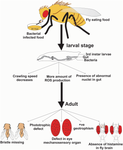Invertebrate Neuroscience Pub Date : 2019-10-22 , DOI: 10.1007/s10158-019-0233-y Subhashree Priyadarsini 1 , Moumita Sahoo 2 , Swetapadma Sahu 1 , Rasu Jayabalan 2 , Monalisa Mishra 1

|
Abstract
The effects of teeth-blackening bacteria Enterobacter ludwigii on the physiological system were investigated using the model organism Drosophila melanogaster. The bacteria were mixed with the fly food, and its effect was checked on the growth, development and behaviour of Drosophila. Microbes generate reactive oxygen species (ROS) within the haemolymph of the larvae once it enters into the body. The increased amount of ROS was evidenced by the NBT assay and using 2’,7’–dichlorofluorescin diacetate dye, which indicates the mitochondrial ROS. The increased amount of ROS resulted in a number of abnormal nuclei within the gut. Besides that larvae walking became sluggish in comparison with wild type although the larvae crawling path did not change much. Flies hatched from the infectious larvae have the posterior scutellar bristle absent from the thorax and abnormal mechanosensory hairs in the eye, and they undergo time-dependent neurodegeneration as evidenced by the geotrophic and phototrophic assays. To decipher the mechanism of neurodegeneration, flies were checked for the presence of four important bioamines: tyramine, cadaverine, putrescine and histamine. Out of these four, histamine was found to be absent in infected flies. Histamine is a key molecule required for the functioning of the photoreceptor as well as mechanoreceptors. The mechanism via which mouth infectious bacteria E. ludwigii can affect the development and cause age-dependent neurodegeneration is explained in this paper.
Graphic abstract
中文翻译:

路德维氏肠杆菌感染影响果蝇的发育并导致年龄依赖性神经变性
摘要
使用模式生物果蝇研究了牙齿变黑细菌路德维氏肠杆菌对生理系统的影响。将细菌与蝇食混合,检查其对果蝇生长、发育和行为的影响。一旦微生物进入体内,就会在幼虫的血淋巴中产生活性氧(ROS)。 NBT 测定和使用 2',7'-二氯荧光素二乙酸酯染料证明了 ROS 量的增加,这表明了线粒体 ROS。 ROS 量的增加导致肠道内出现许多异常细胞核。此外,尽管幼虫爬行路径没有太大变化,但与野生型相比,幼虫行走变得缓慢。从传染性幼虫孵化出来的果蝇胸部没有后盾片刚毛,眼睛里有异常的机械感觉毛发,并且它们经历了时间依赖性神经变性,如地养和光养测定所证明的那样。为了破译神经退行性变的机制,研究人员检查了果蝇是否存在四种重要的生物胺:酪胺、尸胺、腐胺和组胺。在这四种果蝇中,发现受感染的苍蝇中不存在组胺。组胺是光感受器和机械感受器发挥功能所需的关键分子。本文解释了口腔感染性细菌路德维氏大肠杆菌影响发育并导致年龄依赖性神经变性的机制。











































 京公网安备 11010802027423号
京公网安备 11010802027423号